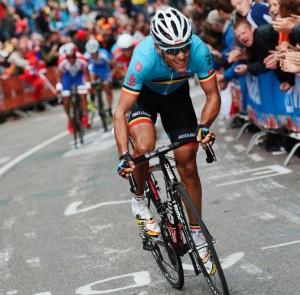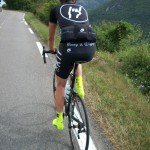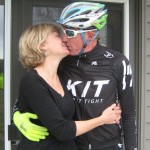By guest KIT blogger, Eletrico
 How is winter treating you? Did you make the most of the festivities, the company parties, the nutmeg-flavored brews? Then as winter prepared its glorious entry, you kept busy enjoying your buddies’ ballyhoos, your crew’s hootenannies, never mind the “Hey, try this new beer. It’s even nutmeg-ier and thicker than last year’s version!” Plus Christmas, Hanukkah and general end of year holiday celebrations we can’t just shake off. After all, you can’t pick a favorite and go to one party only, can you? Better yet, could you? Folks use this period to let go of all of their food intake inhibitions and just go to town. Imagine driving through Foodville on a convertible, setting up the auto pilot and grabbing and stuffing your face as you roll through, nary a hint of concern about tomorrow. So now that the caloric stretch between Halloween and New Year’s Eve has ended, you’re left to stretch the elastic in your sweatpants because your extra kilos said “see ya later” to your slim fit clothes (which don’t fit as slimly as they did back in the summer). Oh well. Hangover ensues, and its metallic aftertaste reaches a zenith when the thought of resolutions for the present year slaps you in the face. Time to act, re-think your options, your goals, face your demons and get to work. So what have you promised yourself for the upcoming year? Those sorts of questions can be potentially disorienting, invasive and basically annoying to the questionee. Especially because we’re addressing the topic of 2013 one month in arrears; we’re in February already, and we’re daring you to come up with a self-written score for the upcoming year. What nerve.
How is winter treating you? Did you make the most of the festivities, the company parties, the nutmeg-flavored brews? Then as winter prepared its glorious entry, you kept busy enjoying your buddies’ ballyhoos, your crew’s hootenannies, never mind the “Hey, try this new beer. It’s even nutmeg-ier and thicker than last year’s version!” Plus Christmas, Hanukkah and general end of year holiday celebrations we can’t just shake off. After all, you can’t pick a favorite and go to one party only, can you? Better yet, could you? Folks use this period to let go of all of their food intake inhibitions and just go to town. Imagine driving through Foodville on a convertible, setting up the auto pilot and grabbing and stuffing your face as you roll through, nary a hint of concern about tomorrow. So now that the caloric stretch between Halloween and New Year’s Eve has ended, you’re left to stretch the elastic in your sweatpants because your extra kilos said “see ya later” to your slim fit clothes (which don’t fit as slimly as they did back in the summer). Oh well. Hangover ensues, and its metallic aftertaste reaches a zenith when the thought of resolutions for the present year slaps you in the face. Time to act, re-think your options, your goals, face your demons and get to work. So what have you promised yourself for the upcoming year? Those sorts of questions can be potentially disorienting, invasive and basically annoying to the questionee. Especially because we’re addressing the topic of 2013 one month in arrears; we’re in February already, and we’re daring you to come up with a self-written score for the upcoming year. What nerve.
In general, when we stir afflictions about the collective fitness plans, we’re often hit with the “I’ll think of it tomorrow”, or “when I pass the exam”, or when “things get a little less crazy”. But this type of tomorrow never really materializes because, well, things never get less crazy; no matter how casually folks hope it to happen. It seems as if people expect some sort of divine intervention to start (or resume) physical activity, a signal from the almighty, so to speak.
The point here is to quit expecting the next chapters to be divinely unfolded; for the workout lifers out there who have families and obligations, there is an understanding that the luxury of time and the several steps it takes to get fit don’t come by easily. Patience and goodwill are but limited commodities, so the KIT idea I try to get across is to be consistent and to maintain an above-average level of fitness at all times. You don’t know if junior will be sick next week, curtailing your plans; you don’t know if your work will be demanding those extra precious exercise hours you need so badly. For those overwhelmed with the onslaught of family activities, it can be a daunting task sneaking out for a run or hitting the rollers downstairs for a quick, mini hammer session….but you gotta do it. My pal Dimitri once called me a “loose cannon” due to my “go/stop/wait/swap riding time/swap again” schedule of riding. It is true that having a toddler and a pre-toddler qualifies me in the “thick of it” category, and that I have missed numerous kilometer sessions with buddies due to unforeseen, last minute surprises. What I have learned and am still learning, is that improvisation skills and an open, willing mind come in handy during this period.
![img008[1]](https://ikeepittight.com/wp-content/uploads/2013/02/img0081.jpg) The knowledge that my athletic plans surf a wave of fluidity insists that I be realistic with my objectives, and being aware of this reality provides for a modicum of harmony. The sports we play (pick one: cycling, triathlon, running,rowing) ) are fortunately well-served in our community, so missing any given event is not the end: there’ll be plenty of opportunities to make up tomorrow, next week, or next month – and that cools my nerves. Therefore, as an athlete I figured that the need for consistent and creative work is an ever-present element. Consistent as in every effort counts, every session matters, regardless of its length (or lack thereof). The creative part depends on you: as a refined, “mature” athlete one understands the building blocks that are part of a good fitness foundation. But sometimes the workout can be so short that if all we can do is a smash and grab session, so be it. As an example, Tabata intervals (20 seconds of ultra-intense exercise followed by 10 seconds of rest, repeated continuously for 4 minutes) fall in this category, and are highly recommended for their benefits; besides, one can go hard for quick periods and still recover properly. Notice I mentioned “mature”, not “old”. You can be a mature racer who is really fast, as we know that fitness is a constant that doesn’t age; lack of activities, on the other hand, will make you grow bent, stiff and cracked, like an old tree with many season rings. I have found that having goals, or at least having a semblance of focus can be of enormous help for the duties-addled athlete.
The knowledge that my athletic plans surf a wave of fluidity insists that I be realistic with my objectives, and being aware of this reality provides for a modicum of harmony. The sports we play (pick one: cycling, triathlon, running,rowing) ) are fortunately well-served in our community, so missing any given event is not the end: there’ll be plenty of opportunities to make up tomorrow, next week, or next month – and that cools my nerves. Therefore, as an athlete I figured that the need for consistent and creative work is an ever-present element. Consistent as in every effort counts, every session matters, regardless of its length (or lack thereof). The creative part depends on you: as a refined, “mature” athlete one understands the building blocks that are part of a good fitness foundation. But sometimes the workout can be so short that if all we can do is a smash and grab session, so be it. As an example, Tabata intervals (20 seconds of ultra-intense exercise followed by 10 seconds of rest, repeated continuously for 4 minutes) fall in this category, and are highly recommended for their benefits; besides, one can go hard for quick periods and still recover properly. Notice I mentioned “mature”, not “old”. You can be a mature racer who is really fast, as we know that fitness is a constant that doesn’t age; lack of activities, on the other hand, will make you grow bent, stiff and cracked, like an old tree with many season rings. I have found that having goals, or at least having a semblance of focus can be of enormous help for the duties-addled athlete.
Think this for 2013: all exercise matters, so pretend you have a race season starting sooner than you anticipated, or a 20km running event you forgot because you registered 6 months ago. The fire under the belly is the best motivator, year round. It is also impervious to whims, fads and bad weather.
Come on, let’s turn those old wispy limbs with many season rings into seasoned tree trunks on big rings.
Happy New Year. Now get sweatin’!
Keep it tight,
Eletrico
*Elétrico is a local roadie aficionado who enjoys good banter, spirited hammer sessions and awesome beers.


